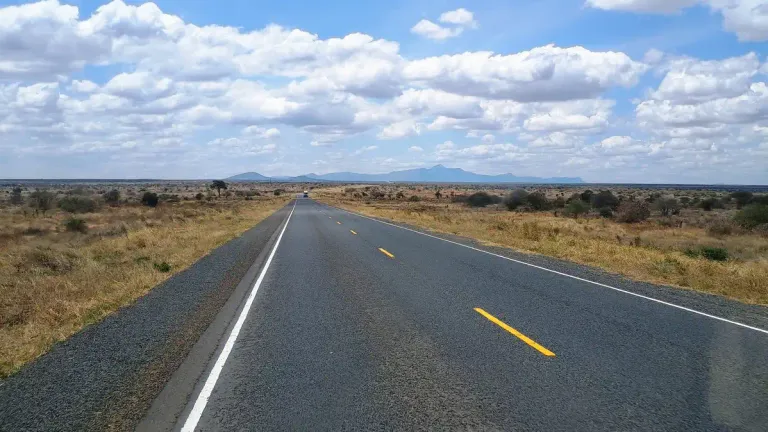
On August 20th, I woke up early in a cozy hostel in Moshi, Tanzania. The day ahead was packed: I had to catch a bus to Mombasa, Kenya. After a quick shower and some efficient—albeit slightly frustrating—packing of my essentials into my trusty 32L Osprey Nebula backpack, I was ready. My life’s belongings fit into this bag, though it's stretched to its limits, requiring a game of Tetris every time I pack. Let’s just say I’m no Tetris champion, so it took a bit longer than planned.

Skipping breakfast, I briskly walked the 15–20 minutes to the bus station. Upon arriving, there was no bus in sight, but a kind woman in the office assured me I was in the right place. True to the unpredictability of African travel, the bus arrived a little late—but it arrived, and I was grateful.

The Long Ride to Mombasa
When I bought my ticket, I’d hoped for the front seat next to the driver, but it was already booked. I settled for the seat right behind, which proved to be uncomfortably tight—my knees stuck out into the aisle like a makeshift roadblock. Thankfully, a fellow passenger noticed my discomfort and graciously offered to swap seats. The front seat made all the difference: ample space and an unobstructed view of the road ahead.
The bus gradually filled to capacity as we left Moshi, picking up passengers along the way. African buses are the epitome of efficiency; when every seat is taken, people perch on buckets or boxes in the aisle. Yet, in the front seat, I felt a rare sense of comfort amidst the chaos.

Crossing the border into Kenya at Taveta went smoothly, though not without its quirks. The immigration officer struggled to scan the QR code of my e-visa, so I pulled up the PDF version on my phone. Pro tip: always carry a printed copy of your e-visa for such situations. At the border, I met a Swiss-French family who kindly offered me a ride to Mombasa in their private car. Tempting as it was, I chose to stick with the bus—there’s something about old buses that hold a charm of their own.
Kilifi: Finding Rest in Coastal Kenya
By the time we reached Mariakani, I decided to hop off and catch a matatu (shared minibus) directly to Kilifi, hoping to save time by bypassing Mombasa. This turned out to be a mistake. The matatu took forever to fill, and I spent hours waiting in the sweltering heat. By the time I arrived in Kilifi, the day had stretched long, and darkness was settling in. Exhausted but relieved, I stopped for a cold Coke at a corner shop before heading to my accommodation—a modest house that, while central and affordable, lacked ventilation and was uncomfortably hot.

The image above shows the workspace at the café in Express Shop.
The next day, I explored Kilifi on foot, catching up with familiar faces and marveling at the improvements around town. The park had undergone significant repairs, and a new café run by a local Indian family became my go-to spot for coffee and laptop work. My old Chromebook had been replaced with a used ThinkPad running Linux—a nostalgic return to my tech roots.
Slow Living in Kilifi
I spent three months in Kilifi, enjoying a slower pace of life. I skipped the beaches and tourist spots I’d initially planned to visit, opting instead to recharge. Evenings were often spent on the rooftop, savoring the cool ocean breeze and watching the sun set over the Indian Ocean. Conversations with locals and German expats living in Kenya enriched my time here, adding depth to the experience.

The image above features my old Osprey Nebula backpack, which served me well for 18 months, alongside my new Osprey Farpoint 40. While I love the Nebula's design and color, it wasn’t durable enough for the demands of full-time travel and living out of a backpack.
As my stay neared its end, I prepared for my next adventure. I upgraded my gear: a new Osprey Farpoint 40 backpack (goodbye, overstretched Nebula), a Cocoon Board for organizing small items, and a replacement for my titanium spork, confiscated during airport security in Egypt. Each new item felt like a small victory, though shipping costs and import taxes took a toll on my budget.
Onward to Tanzania
On November 18th, with my new backpack neatly packed, I left Kilifi at dawn. The journey back to Moshi was an adventure in itself, involving minibuses and motorbike taxis. Kilifi had been a place of rest and reflection, but the road was calling once again.

Stay tuned for my upcoming posts about my travels in Tanzania, where new landscapes and stories awaited. Don’t forget to follow along here on the blog or on Nostr for updates!


The image above captures the view from the rooftop overlooking Kilifi, with a fire visible in town. Fires in Africa can be devastating, but Kilifi now has a new fire truck, offering a glimmer of hope for better emergency response.

Both images, above and below, showcase the view from my sunset relaxation spot on the rooftop in Kilifi.

The following images show the park in Kilifi and the beach just below it. This isn’t a beach I’d swim at, but it features mangroves along the sides, adding to its natural charm.








The image below shows me early in the morning heading to the stage to catch my matatu in Kilifi, ready to move on to Tanzania.
